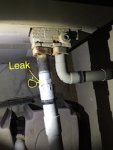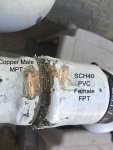- Mar 5, 2017
- 603
- Pool Size
- 17000
- Surface
- Plaster
- Chlorine
- Salt Water Generator
- SWG Type
- Hayward Aqua Rite (T-9)
Hi All,
I've gotten so much outta TFP that I was more than happy to donate to become a bronze supporter. I maintain my own pool, from repairs to chems, so I really need you folks when I need ya.
Just ventured out and a RWG (repair with goop) I did maybe 3 years ago is leaking again. You can see the staining on the cement, so it's likely been doing this on-and-off for years I'm sure. I cleaned the filter 2 weeks ago, and when empty the filter isn't firmly planted on ground and torques the long PVC run and I'm sure that's how the leak keeps returning.
It's the PVC from filter going into the copper heater inlet. I painted the area white, so it's not new. I presume/hope it's a sweated-in threaded copper adapter (see link) with a threaded 1.5" SCH40 PVC screwed into it with the teflon or other sealant broken down and that's the leak. I covered the leak area it in epoxy 3 years ago (I didn't know what I was doing back then ) and I guess it's time to do it right and do a re-plumb.
) and I guess it's time to do it right and do a re-plumb.
What's the consensus on how to get a leak-proof threaded connection between copper & PVC? Just teflon tape, or the liquid (yellow goop)? I read also pipe dope? Is there a type? Should I use PVC primer for the threaded area? Will I need to put in a new sweated copper treaded adapter also?
Thanks!
Shop NIBCO 1-1/2-in x 1-1/2-in Copper Threaded Adapter Fitting at Lowes.com
I've gotten so much outta TFP that I was more than happy to donate to become a bronze supporter. I maintain my own pool, from repairs to chems, so I really need you folks when I need ya.
Just ventured out and a RWG (repair with goop) I did maybe 3 years ago is leaking again. You can see the staining on the cement, so it's likely been doing this on-and-off for years I'm sure. I cleaned the filter 2 weeks ago, and when empty the filter isn't firmly planted on ground and torques the long PVC run and I'm sure that's how the leak keeps returning.
It's the PVC from filter going into the copper heater inlet. I painted the area white, so it's not new. I presume/hope it's a sweated-in threaded copper adapter (see link) with a threaded 1.5" SCH40 PVC screwed into it with the teflon or other sealant broken down and that's the leak. I covered the leak area it in epoxy 3 years ago (I didn't know what I was doing back then
What's the consensus on how to get a leak-proof threaded connection between copper & PVC? Just teflon tape, or the liquid (yellow goop)? I read also pipe dope? Is there a type? Should I use PVC primer for the threaded area? Will I need to put in a new sweated copper treaded adapter also?
Thanks!
Shop NIBCO 1-1/2-in x 1-1/2-in Copper Threaded Adapter Fitting at Lowes.com





